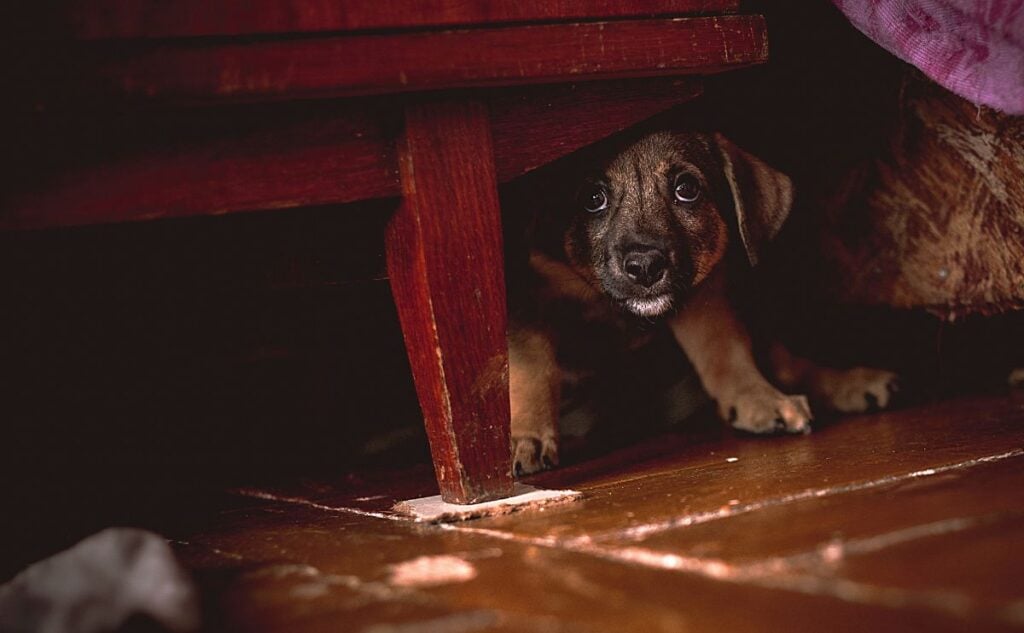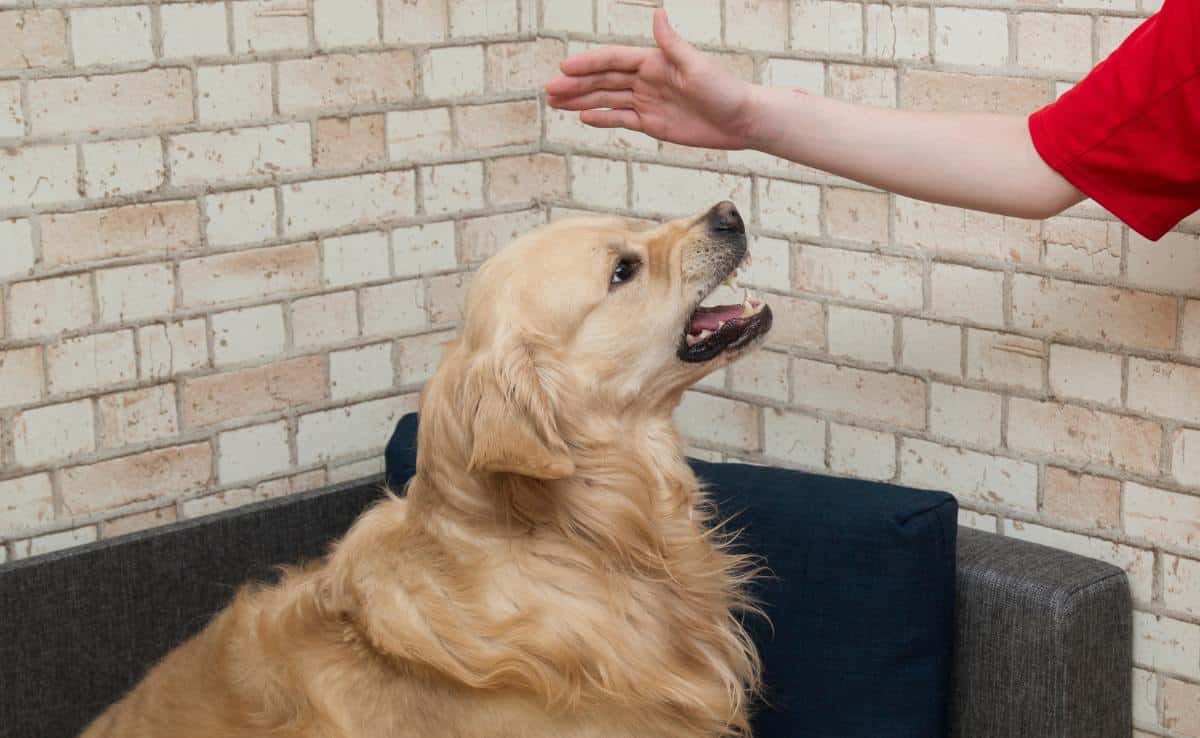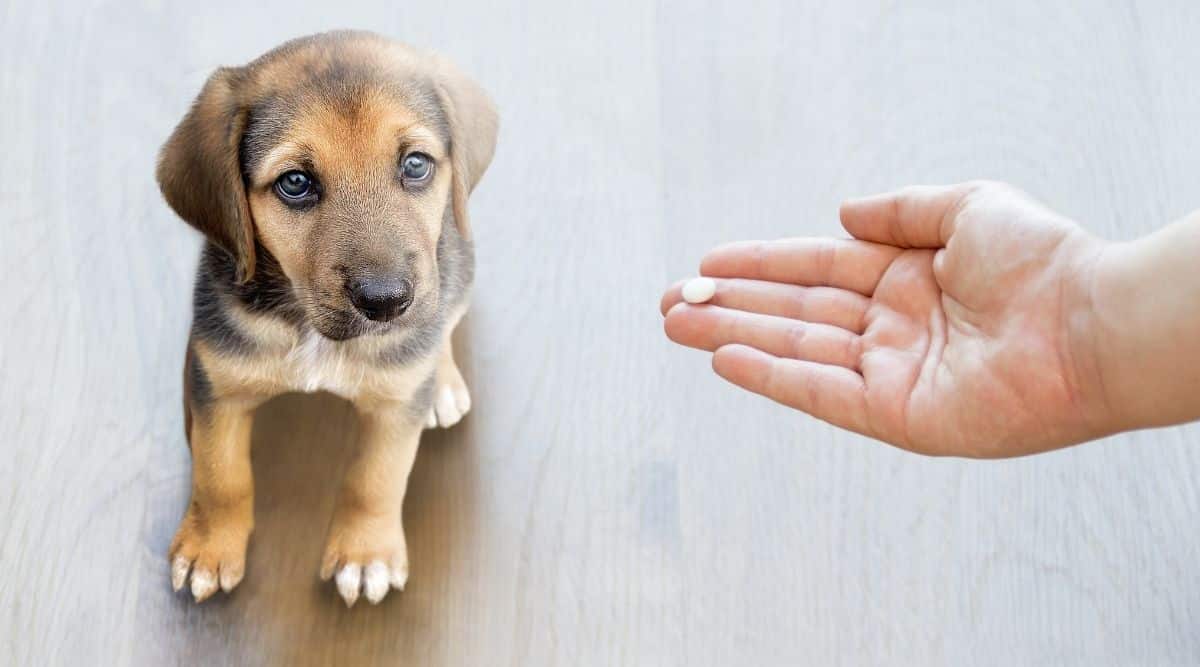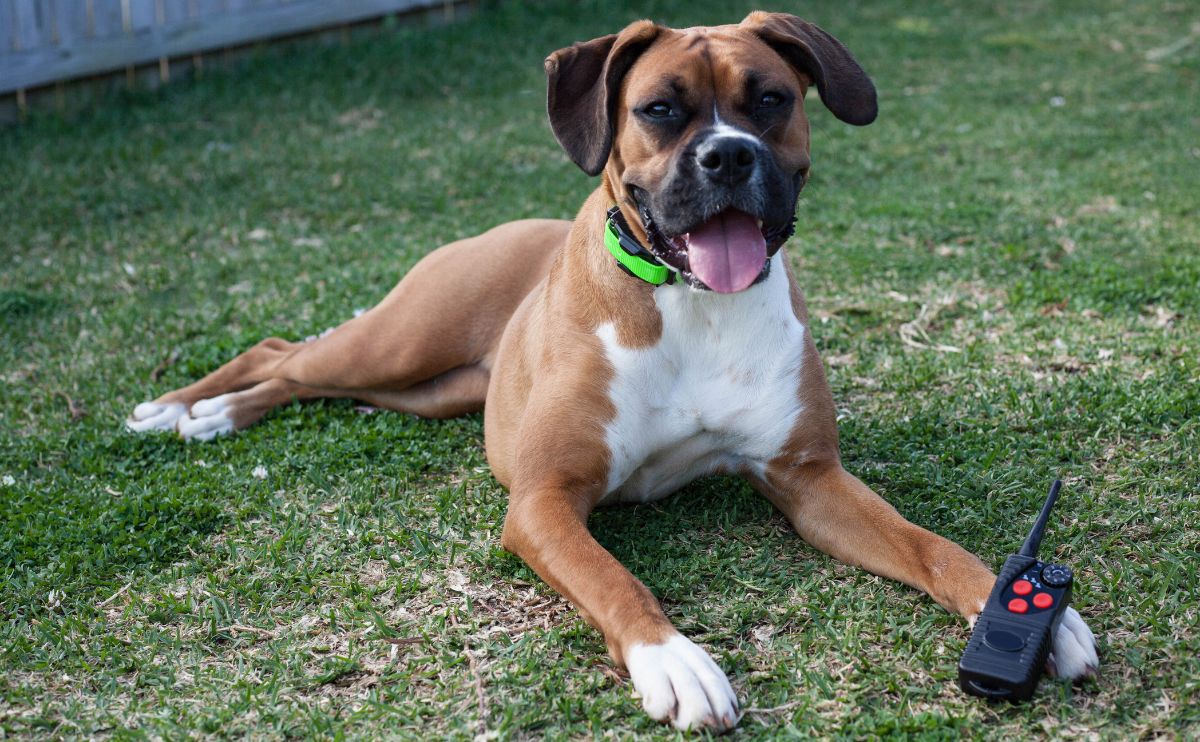From Fearful To Fearless: Helping Your Pooch Through Puppy Fear Periods
When you purchase through links on our site, we may earn a commission. Here’s how it works.

Bringing a new puppy into your home is an exciting and rewarding experience. But as they grow, you may notice sudden changes in their behavior. A once confident and curious puppy might suddenly become hesitant, startled, or fearful of things they were previously comfortable with. This shift can be surprising, but it is a normal part of development known as a puppy fear period.
Table of Contents
While fear periods in dogs can be challenging for both puppies and their owners, understanding them can help you provide the right support and reassurance to ensure your pup grows into a confident, well-adjusted companion. I explore what they are, the two common puppy fear periods, how to handle them, and other tips to help your puppy navigate this seemingly tough time.
What Are Puppy Fear Periods?
Puppy fear periods are stages in a puppy’s development when they can become especially sensitive or frightened by new experiences, people, or environments. These periods are a normal part of a puppy’s growth and typically occur in the first year of life, although the exact timing can vary between individual puppies. During these phases, a puppy may seem more skittish, anxious, or reactive to things that wouldn’t normally bother them. Here are the common signs of puppy fear stages:
- Sudden fear of people, objects, or environments they were previously comfortable with
- Cowering, hiding, or trying to avoid certain situations
- Increased barking, growling, or reactivity towards perceived threats
- Hesitation or refusal to walk in specific areas
- Seeking reassurance from their owner more than usual
During puppy fear periods, they may react strongly to unfamiliar stimuli, such as loud noises, new people, or even novel environments. These episodes of fear can be triggered by things as simple as a sudden change in their routine, a new object appearing in the house, or an unexpected loud sound like a door slamming or thunder.
While this behavior can be alarming for pet owners, it’s a normal developmental phase. The reason for these fear periods is that puppies are still learning how to navigate the world around them, and their brains are highly impressionable during this time.
2 Common Puppy Fear Stages

Puppies go through various developmental stages, and fear periods are a natural part of their growth. These are the fear stages when puppies become more sensitive to their surroundings, reacting with fear or hesitation to things they might have previously been comfortable with. Understanding these critical stages can help you support your puppy with patience and reassurance, ensuring they grow into confident and well-adjusted adult dogs.
1. First Fear Period In Dogs: 8-11 Weeks
The early fear period typically occurs during the latter part of a puppy’s critical socialization window, which spans from about 3 to 14 weeks. By the time they reach 8 to 11 weeks, puppies are beginning to develop their own sense of the world around them, and their brains are actively absorbing information. This stage is marked by the onset of fear responses to ordinary or familiar things, such as new sounds, people, or objects.
Negative experiences during this period can have long-lasting effects. For instance, if a puppy is startled by a loud noise or a sudden movement, they may form a negative association with that sound or situation. This can lead to a lasting fear of certain objects, situations, or even people. This period is vital for socialization. During this time, positive experiences and gentle exposure to different environments, people, and animals can help prevent future fears. For example, calmly introducing your puppy to new situations can help them build confidence. Watch this short video showing how this puppy was initially fearful of a new toy but quickly became comfortable with it with patience.
2. Second Fear Period In Dogs: 6-14 Months
The second fear period in dogs typically occurs when puppies reach adolescence, around 6 to 14 months of age. This is a time of significant hormonal changes as they begin to mature physically and emotionally. The second fear period often coincides with physical development; the puppy may feel unsure about their place in the world. During this stage, puppies may experience a resurgence of fearful or anxious behavior, even if they previously seemed well-adjusted to certain situations.
Puppies that were previously confident may suddenly become fearful of things they weren’t scared of before. For example, they might become anxious about meeting new people, encountering larger dogs, or being in unfamiliar environments. Fear of certain situations, such as car rides, walking in public spaces, or encountering other dogs, may re-emerge. This can happen even if the puppy has had positive experiences with these things in the past.
How Long Do Puppy Fear Periods Last?

The duration of a puppy’s fear period can vary depending on factors such as breed, temperament, genetics, and previous experiences. Generally, each fear period lasts anywhere from a few days to a couple of weeks. However, some puppies may have lingering sensitivity beyond this timeframe, particularly if they experience a strong adverse reaction to something during this stage.
The first fear period in dogs tends to be brief, often lasting a few days to a week. Since it occurs during the crucial socialization window, puppies are still highly adaptable. If handled correctly, they can quickly overcome minor fears. The second fear period in dogs can be more unpredictable. Some dogs may go through it quickly (within a week or two), while others might experience fluctuations in confidence over several months. It often depends on the individual dog’s maturity rate, other behavioral problems, hormonal changes, and environmental influences.
Why Does The Length Of A Fear Period Vary?
- Breed Differences. Some breeds mature faster than others. Large breeds, for example, take longer to develop, so their second fear period might extend further into adolescence.
- Individual Sensitivity. More cautious or nervous puppies may take longer to work through their fears, especially if they are naturally shy.
- Past Experiences. Puppies with mostly positive interactions with their environment may quickly move through a fear period. In comparison, those with limited socialization or negative experiences may struggle for longer.
Understanding & Training Through Fear Periods
The way a puppy reacts during a fear period can vary. This is because puppies are still building trust and understanding of their environment. The things they encounter at this stage can leave a lasting impression, which is why positive, calm experiences are so crucial. Puppies tend to be more sensitive to certain stimuli during these fear periods because their socialization and emotional development are still in the early stages. They haven’t fully developed the coping mechanisms that older dogs have, and their emotional responses can be much more intense.
Be mindful of the puppy’s reactions and avoid overwhelming them with too much stimulus. This is why, especially during these phases, it’s important to avoid punishing fearful behavior. Instead, reinforcing positive associations and offering comfort can help them overcome their anxieties and become more resilient. Focus on creating positive associations with new experiences.
Turning Fear Into A Positive Learning Experience

Fearful moments can be unsettling for both puppies and their owners, but with patience and the right approach, these situations can become valuable learning experiences. How you respond to your puppy’s fear can shape their confidence and resilience in the long run. Instead of forcing them to face their fears head-on, focus on gradual exposure, positive reinforcement, and allowing them to move at their own pace. Here’s a step-by-step guide to helping your puppy work through their fears in a healthy way:
1. Give Your Puppy Space To Retreat
When your puppy encounters something that frightens them, their first instinct may be to move away. Allow them to do so without forcing them to confront the object too soon. Giving your puppy control over the situation helps them feel safer and prevents their fear from escalating into panic. Watch their body language – signs like tucked tails, pinned ears, or backing away indicate discomfort. If they choose to observe the scary object from a distance, that’s perfectly okay.
2. Reward Engagement & Reassurance-Seeking
Instead of trying to comfort your puppy with excessive petting or cooing, which can sometimes reinforce fearful behavior, focus on rewarding calm engagement. If your puppy looks at the object that scared them, offer praise and a treat. This teaches them that facing their fears, even from a distance, leads to positive outcomes. If they glance at you for reassurance, reward that too – this strengthens their trust in you as a source of safety and guidance.
3. Allow Your Puppy To Control Their Approach
Never force your puppy closer to the thing that scared them, and avoid luring them forward with treats. This can backfire, as it puts pressure on them and may increase their anxiety. Instead, let them decide if and when they want to get closer. Reward any small signs of curiosity, such as looking at the object, stepping towards it, sniffing, or wagging their tail. This gradual, pressure-free approach helps build confidence over time.
4. Keep Training Sessions Short & Positive
Patience is key when working through fear. If your puppy doesn’t completely overcome their fear in one session, don’t worry – it’s completely normal. Keep interactions brief, fun, and stress-free. Even small progress, like a hesitant sniff or a relaxed posture, is a step in the right direction. Always end on a positive note by rewarding your puppy with training treats, praise, or playtime to reinforce good experiences.
5. Maintain A Calm, Casual Attitude In Future Sessions
Dogs take emotional cues from their owners, so they may become even more anxious if you make a big deal out of their fear. Instead, act as though the scary object is no big deal and continue to incorporate it into everyday life. Use a toy or fun activity to redirect their attention and help them engage with the object in a relaxed way. Let them explore at their own pace and remain at a comfortable distance.
Are Fear Periods The Same For All Breeds?

No, fear periods are not the same for all breeds. While all puppies go through fear periods as part of their development, the intensity, duration, and specific triggers can vary significantly depending on breed traits, genetic predisposition, and individual temperament. Some breeds are naturally more confident and resilient, while others are more cautious or sensitive to their environment. Here’s how different breed groups may experience fear periods differently:
Guardian & Working Breeds
Guarding breeds such as German Shepherds, Dobermans, Rottweilers, etc, are bred to be alert and protective, which can make them more aware of changes in their environment. They may go through a more pronounced second fear period (6–14 months) when their guarding instincts start developing. Proper, controlled socialization during fear periods is crucial to prevent reactivity or overprotective behavior in adulthood.
Herding Breeds
Herding breeds such as Border Collies, Corgis, and Australian Shepherds are highly intelligent and sensitive, meaning they may react more intensely to sudden changes or unfamiliar stimuli. Because they are bred to be responsive to their surroundings, they may develop fears of certain objects, noises, or movement patterns (e.g., bicycles, skateboards, or fast-moving people). Fear periods may last slightly longer due to their heightened awareness and quick learning ability.
Toy & Small Breeds
Small breeds, such as Chihuahuas, Dachshunds, and Pomeranians, are generally more prone to fearful behavior as they are physically more vulnerable. Their fear periods may appear more intense or prolonged, especially if they are frequently exposed to larger dogs or overwhelming environments. They may require extra patience and gradual exposure to new experiences to help them build confidence.
Sporting & Retriever Breeds
Typically, social and outgoing sporting breeds like Labradors, Golden Retrievers, and Spaniels may have milder fear periods than others. However, individual temperament plays a significant role – some may be extra sensitive to new experiences or loud noises. Because they are often eager to please, reward-based training can be highly effective in helping them work through fears.
Sighthounds & Primitive Breeds
Some breeds, especially those with independent natures, like Greyhounds, Basenjis, and Shiba Inus, may withdraw rather than confront their fears. They might be more reserved or aloof and need extra patience and gentle encouragement to engage with their surroundings. Overexposure or forcing interactions during fear periods can be counterproductive for these breeds.
Most Important Canine Fear Period Takeaways

- Be Patient & Don’t Panic. Keep a calm and reassuring attitude, as puppies can pick up on their owner’s anxiety and may become more scared if they sense distress.
- Individual Variability. Even within a breed, each puppy is unique. Genetics, early socialization, and previous experiences greatly influence how fear periods manifest. Two puppies of the same breed may react differently. One might breeze through fear periods with little issue, while another might need extra reassurance and training.
Frequently Asked Questions
We understand that puppy fear periods can be a confusing and sometimes stressful part of raising a young dog. Every puppy is different, and their experiences during these developmental stages can vary. That’s why we’re here to help! If you don’t see your question answered in our FAQ section, I encourage you to ask us in the comments. Your experiences and questions can also help other puppy owners facing the same challenges. So don’t hesitate to share your concerns, and let’s navigate this critical stage of puppyhood together!
Can A Bad Experience During A Fear Period Have Long-Term Effects?
Yes, negative experiences during a fear period can lead to long-term anxiety or behavioral issues. This is why managing fear-inducing situations carefully is essential, ensuring your puppy has positive or neutral experiences rather than traumatic ones.
Should I Socialise My Puppy During A Fear Period?
Yes, but do so gently. Continue exposing your puppy to new experiences, but at a pace they’re comfortable with. Avoid overwhelming environments and focus on controlled, positive interactions.
Will My Puppy Grow Out Of Their Fears?
Most puppies naturally move past fear periods. However, fears that are reinforced through negative experiences or lack of exposure may persist into adulthood. Consistent, positive reinforcement can help prevent long-term issues.
When Should I Seek Professional Help For Fear Periods In Dogs?
If your puppy’s fear is extreme, persistent, or worsens over time, consult a professional trainer or behaviorist. Early intervention can help prevent fear from turning into lasting anxiety or aggression. We have reviewed the best dog training apps to help you train your pup at any time, as well as professional help from trainers such as DIYK9.
Other Puppy Must-Haves
Bringing home a new puppy is an exciting adventure, and having the right essentials can set them up for a happy, healthy start. A high-quality puppy diet tailored to their nutritional needs is crucial for proper growth and development, providing essential vitamins, minerals, and protein. Puppy teething toys are a must to soothe sore gums and prevent destructive chewing on furniture or shoes. A puppy checklist can help ensure you don’t forget essential items. Additionally, setting up a safe space with a puppy playpen can give your pooch a sense of security as they adjust to their new home. With the right supplies and preparation, you’ll be ready to welcome your furry friend and help them thrive through their fear periods!
Do you have a puppy going through canine fear periods? Perhaps you’re unsure whether your puppy is going through a puppy fear stage and need some advice. Get in touch with us in the comments section below.
Why Trust Canine Journal
Emma is a devoted dog mom to Chips, her charming Dachshund, and Bonkers, her uniquely adorable Bull Terrier mix. With years of hands-on experience as a professional dog walker and sitter, Emma has cared for hundreds of dogs and has yet to meet a pup that hasn’t experienced canine fear periods. As a dedicated canine researcher and writer, she works alongside an experienced team at Canine Journal to provide dog owners with the most accurate, well-researched, and up-to-date information.



